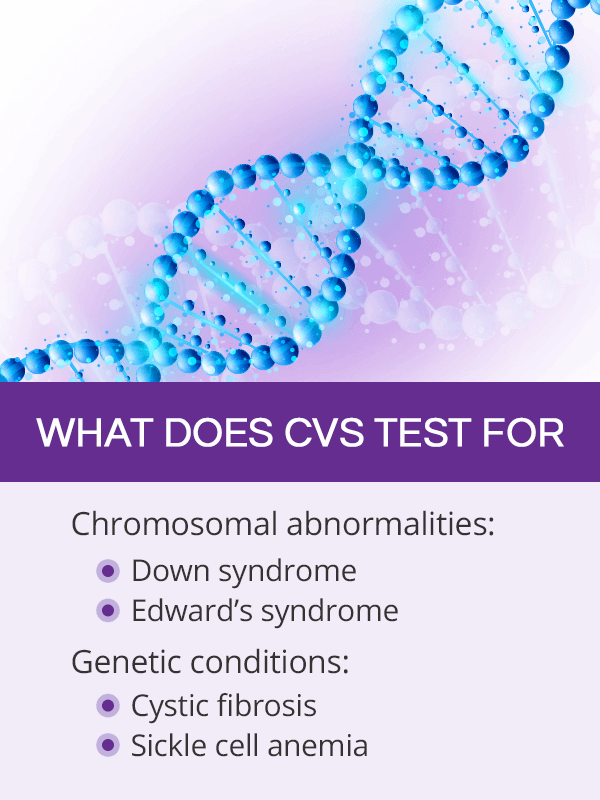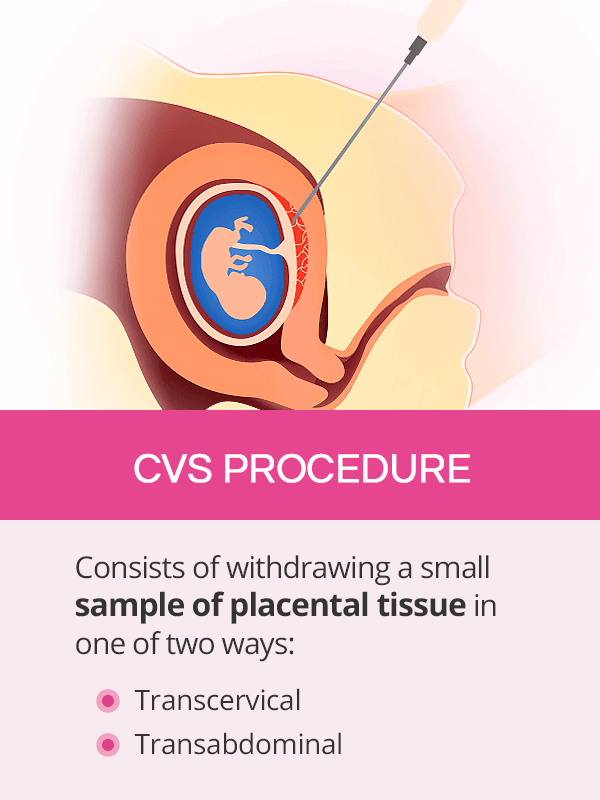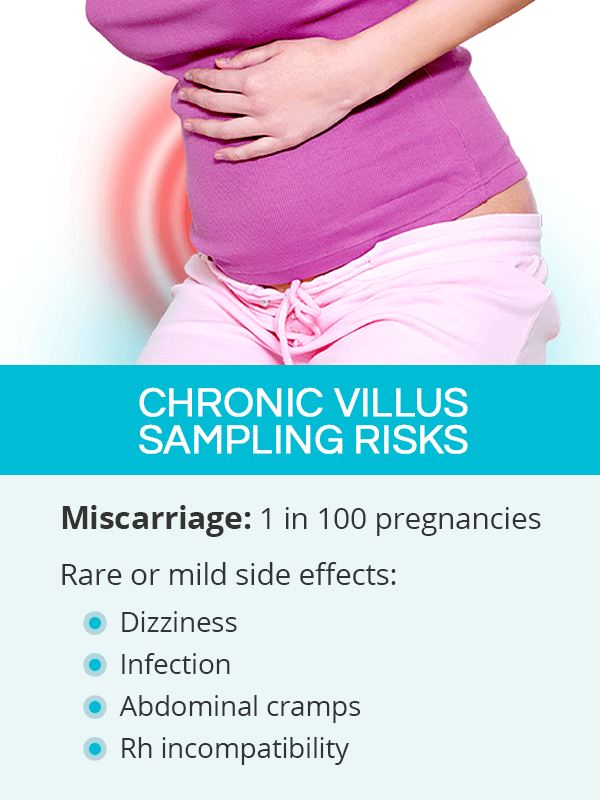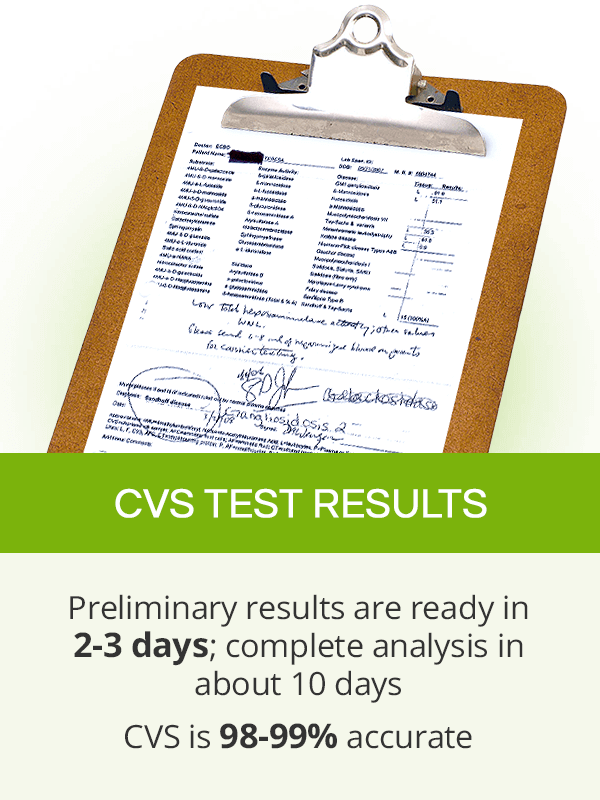What is a Chorionic Villus Sampling?

Chorionic villus sampling is a type of diagnostic prenatal genetic testing, which can be offered to some pregnant women in the first trimester, between the 10th and 13th weeks of pregnancy1. It consists of withdrawing a sample of the placenta from the womb and testing it for genetic abnormalities.
CVS is an invasive test used to confirm or rule out genetic abnormalities, in contrast to screening tests, which only evaluate the risk of the child having such abnormalities. As such, CVS is not a routine prenatal test.
What does CVS Test for?
CVS is used to test whether the fetus has chromosomal abnormalities or genetic conditions, including Down syndrome, cystic fibrosis, sickle cell anemia, Edward's syndrome, or Tay-Sachs disease, among others.
Although CVS tests for over a hundred different conditions, it does not test for all existing ones. Also, unlike a similar genetic testing called amniocentesis, CVS does not test for neural tube defects, such as spina bifida.
Who Needs a CVS?
A CVS procedure is generally recommended to women in one of two instances:
Positive results of screening tests, like the first trimester maternal serum
Risk factors for genetic conditions, including advanced maternal age; family history of genetic conditions; one or both parents being a carrier of a genetic disorder; history of a miscarriage; or having a child with birth defects; among others
CVS Procedure

The entire CVS procedure takes about 30 minutes, although withdrawing of the sample takes about a few minutes. It is done on an outpatient basis, which means it does not necessitate an overnight stay at the hospital.
The main objective of the CVS procedure is to obtain a small sample of the placental tissue. There are two ways to perform the procedure2:
Transcervical: by inserting a thin catheter through the cervix to the placenta
Transabdominal: by inserting a thin needle through the abdomen to the uterus and the placenta
In both cases, the CVS procedure is guided through an ultrasound. The sample will be sent to the laboratory for further analysis. Because the placenta has grown from the same cells as the fetus, placental genetic abnormalities will also exist in the fetus.
After the procedure, a woman will stay in the clinic for a while longer to make sure she and the baby are in good health. Although she can resume normal daily activities the next day, she will likely be advised not to engage in heavy lifting, sex, or strenuous exercise for two more days.
Chronic Villus Sampling Risks

CVS is usually a safe and painless procedure. However, as an invasive test, it does carry some risks of potential complications, the biggest one being a heightened risk a miscarriage (1 in 100 pregnancies1).
Other possible chorionic villus sampling risks include the following:
- Dizziness
- Rh incompatibility
- Abdominal cramps or discomfort
- Infection
- Amniotic sac rupture
- Hemorrhage
If the procedure is performed at 10 weeks or sooner, there is a higher risk of defects concerning the baby's limbs3.
If a woman notices heavy vaginal bleeding or fluid discharge as well as severe cramping or fever, she should consult with her doctor right away to rule out possible complications.
CVS Test Results

Initial CVS test results might be available in two to three days, but the full analysis might take about 10 days4.
While a CVS procedure is 98-99% accurate in diagnosing chromosomal abnormalities, the results do not provide cues to their extent and severity1. It also does not test for birth defects.
CVS is often perceived as more advantageous than amniocentesis, which is done later in pregnancy, between the 15th and 20th weeks. Finding out that the child has certain chromosomal changes a few weeks sooner gives couples more time to come to terms with the results and decide on the next step.
- Couples usually consider one of the following options:
- Prepare for having a child with some extent of disability or special needs
- Arrange for giving the child up for adoption after birth
- Consider abortion to terminate pregnancy
Throughout the process, couples can take advantage of genetic counseling to better understand their alternatives.
Key Takeaway
Chorionic villus sampling is a prenatal genetic testing that can be offered to women between the 10th and 13th weeks of pregnancy, either based on abnormal results of other tests or due to certain risk factors that put them at risk of having a child with a genetic condition. It consists of taking a sample of the placenta for testing, either by inserting a thin catheter through the cervix to the uterus or accessing the placenta through the abdomen with a thin needle. Although it is generally considered safe and painless, CVS comes with an increased risk of miscarriage, which has been observed in 1 in every 100 pregnancies. Other potential side effects, such as dizziness or infections, are rare and usually mild. The CVS test results are 98-99% accurate in diagnosing genetic conditions and chromosomal abnormalities, like Down syndrome or cystic fibrosis, but they do not test for birth defects.
Sources
- Better Health Channel. (2014). Pregnancy tests - chorionic villus sampling. Retrieved July 11, 2019 from https://www.betterhealth.vic.gov.au/health/conditionsandtreatments/pregnancy-tests-chorionic-villus-sampling
- Cochrane. (2017). Amniocentesis and placental sampling for pre-birth diagnosis. Retrieved July 11, 2019 from https://www.cochrane.org/CD003252/PREG_amniocentesis-and-placental-sampling-pre-birth-diagnosis
- International Journal of Fertility & Sterility. (2012). Comparison of Complications of Chorionic Villus Sampling and Amniocentesis. Retrieved July 11, 2019 from https://www.ncbi.nlm.nih.gov/pmc/articles/PMC4152188/
- NHS. (2018). Chorionic villus sampling. Retrieved July 11, 2019 from https://www.nhs.uk/conditions/chorionic-villus-sampling-cvs/what-happens/
- Obstetrics and Gynecology Clinics of North America. (2017). Prenatal testing. Retrieved July 11, 2019 from https://www.ncbi.nlm.nih.gov/pmc/articles/PMC5548328/
- Planned Parenthood. (2018). What's chorionic villus sampling? Retrieved July 11, 2019 from https://www.plannedparenthood.org/learn/pregnancy/prenatal-care/whats-chorionic-villus-sampling
- Pregnancy, Birth & Baby. (2018). Chorionic villus sampling (CVS). Retrieved July 11, 2019 from https://www.pregnancybirthbaby.org.au/chorionic-villus-sampling-cvs
- The Embryo Project Encyclopedia. (2009). Chorionic villus sampling. Retrieved July 11, 2019 from https://embryo.asu.edu/pages/chorionic-villus-sampling
Footnotes:
- American Pregnancy Association. (2019). Chorionic Villus Sampling: CVS. Retrieved July 15, 2019 from https://americanpregnancy.org/prenatal-testing/chorionic-villus-sampling/
- Medline Plus. (2018). Chorionic villus sampling. Retrieved July 11, 2019 from https://medlineplus.gov/ency/article/003406.htm
- Mayo Clinic. (2019). Chorionic villus sampling. Retrieved July 11, 2019 from https://www.mayoclinic.org/tests-procedures/chorionic-villus-sampling/about/pac-20393533
- Cleveland Clinic. (2017). Chorionic Villus Sampling for Prenatal Diagnosis. Retrieved July 11, 2019 from https://my.clevelandclinic.org/health/diagnostics/4028-chorionic-villus-sampling-for-prenatal-diagnosis
